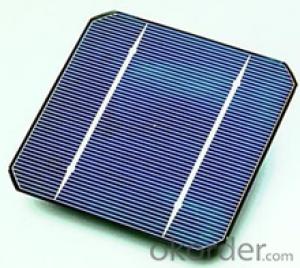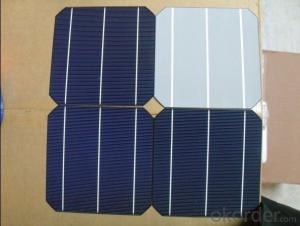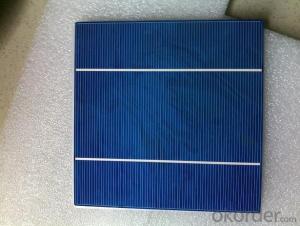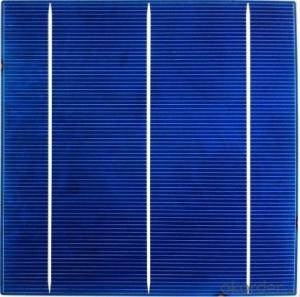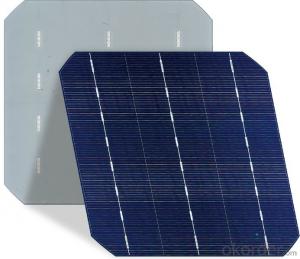Monocrytalline Silicon Solar Cells 156mm (16.50%----18.35%)
- Loading Port:
- Shanghai
- Payment Terms:
- TT OR LC
- Min Order Qty:
- 1000 watt
- Supply Capability:
- 100000000 watt/month
OKorder Service Pledge
OKorder Financial Service
You Might Also Like
Item specifice
1.Description of the Solar Cells
Monocrytalline Silicon Solar Cells 156mm (16.50%----18.35%)
We supply regular mono 125x125mm and poly 156x156mm solar cells.
Cells made in China mainland and Taiwan are both available.
Cell production capacity yearly reach 1GW.
Our cells pattern include continuous and uncontinuous busbar to meet different cells line.
2.Mechanical data and design of the Solar Cells
| Format | 156 mm × 156 mm ± 0.5 mm |
| Thickness- | 210 μm ± 40 μm |
| Front (-) | 1.5 mm bus bars (silver),blue anti-reflection coating (silicon nitride) |
| Back (+) | 2.5 mm wide soldering pads (silver) back surface field (aluminium) |
3. Temperature Coefficient of the Solar Cells
| Voc. Temp .coef.%/K | -0.35%/K |
| Isc . Temp .coef.%/K | +0.024%/K |
| Pm. Temp. coef.%/K | -0.47%/K |
4.Electrical Characteristic of the Solar Cells
Efficiency (%) | Pmpp (W) | Umpp (V) | Impp (A) | Uoc (V) | Isc (A) | FF (%) | ||
18.35 | 4.384 | 0.526 | 8.333 | 0.63 | 8.877 | 78.39% | ||
18.20 | 4.349 | 0.526 | 8.263 | 0.63 | 8.789 | 78.54% | ||
18.05 | 4.313 | 0.525 | 8.216 | 0.63 | 8.741 | 78.32% | ||
17.90 | 4.277 | 0.524 | 8.161 | 0.629 | 8.713 | 78.04% | ||
17.75 | 4.241 | 0.523 | 8.116 | 0.629 | 8.678 | 77.70% | ||
17.60 | 4.206 | 0.521 | 8.073 | 0.628 | 8.657 | 77.36% | ||
17.45 | 4.170 | 0.519 | 8.039 | 0.628 | 8.633 | 76.92% | ||
17.30 | 4.134 | 0.517 | 8.004 | 0.626 | 8.622 | 76.59% | ||
17.15 | 4.098 | 0.516 | 7.938 | 0.625 | 8.537 | 76.80% | ||
17.00 | 4.062 | 0.512 | 7.933 | 0.625 | 8.531 | 76.18% | ||
16.75 | 4.002 | 0.511 | 7.828 | 0.625 | 8.499 | 75.34% | ||
16.50 | 3.943 | 0.510 | 7.731 | 0.625 | 8.484 | 74.36% | ||
5.Intensity Dependence of the Solar Cells
Intensity [W/m2] | sc× [mA] | Voc× [mV] |
1000 | 1.00 | 1.000 |
900 | 0.90 | 0.989 |
500 | 0.50 | 0.963 |
300 | 0.30 | 0.939 |
200 | 0.20 | 0.920 |
6.Applications of the Solar Cells
electric power generation
7.IMages of the Solar Cells
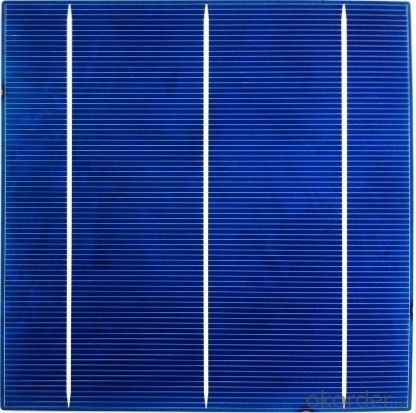

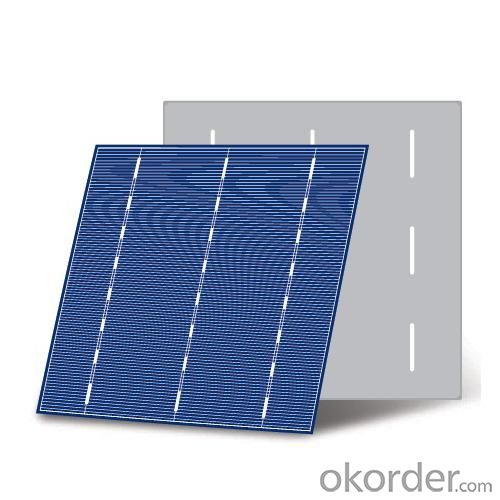
FAQ
- Q:How do solar cells perform in areas with high levels of salt spray?
- Solar cells generally do not perform well in areas with high levels of salt spray. The salt particles can accumulate on the surface of the solar cells, reducing their efficiency by blocking sunlight and corroding the electrical components. Regular cleaning and maintenance are required to mitigate the negative impacts of salt spray on solar panels in such areas.
- Q:What should I know about the Crystalline silicon photovoltaic cells?
- Crystalline silicon photovoltaic cells, known as cSi PV, are made of silicon atoms connected to one another to form a crystal lattice. This lattice comprises the solid material that forms the photovoltaic (PV) cell's semiconductors.
- Q:How do solar cells handle electrical noise or interference?
- Solar cells do not handle electrical noise or interference. They convert sunlight directly into electricity and are not designed to address or mitigate electrical noise or interference.
- Q:Can solar cells be used in recreational vehicles?
- Yes, solar cells can be used in recreational vehicles. They are a popular and effective solution for powering various systems in RVs including lighting, appliances, and electronics. Solar panels can be mounted on the roof of an RV to harness sunlight and convert it into electricity, providing a reliable and sustainable source of power while on the road or during camping trips. Additionally, solar cells offer the advantage of being environmentally friendly and reducing reliance on traditional energy sources.
- Q:Silicon solar cell power generation principle
- When the junction of two different materials formed by the light irradiation, the process of generating electromotive force.The process of the first material absorbs the energy of the photon, resulting in equal number of positive and negative charge, then these charges were migrated to both sides of the knot, The formation of even electricity layer. Although the effect is not generated instantaneous, but the response time is quite short.
- Q:Can solar cells be used for disaster relief efforts?
- Yes, solar cells can be effectively used for disaster relief efforts. Solar cells provide a reliable and sustainable source of energy, which is crucial during emergencies when conventional power sources may be disrupted or unavailable. Solar cells can power essential devices such as lighting, communication equipment, and medical devices in disaster-stricken areas, improving response and recovery operations. Moreover, solar-powered systems can be quickly deployed and are cost-effective in the long run, making them an ideal solution for disaster relief efforts.
- Q:How much energy can a solar cell produce?
- The amount of energy a solar cell can produce largely depends on its size, efficiency, and the amount of sunlight it receives. On average, a typical solar cell can convert around 15-20% of sunlight into usable electricity. Therefore, the energy production can vary, but a single solar cell can typically generate up to a few watts of power.
- Q:What is the effect of dust or dirt on solar cell performance?
- The effect of dust or dirt on solar cell performance is that it reduces the amount of sunlight reaching the solar cells, thereby decreasing their efficiency and overall power output.
- Q:Where and how can I find more information of Photovoltaic Cells Solar Panels? Can anybody share more about that?
- Photovoltaic Cells, known as PV cells, is very special because it has no moving parts, which means you don't need any visual high technology to keep systems up and running.
- Q:What is the impact of fire hazards on solar cells?
- Fire hazards can have a significant impact on solar cells, as they are highly susceptible to damage and destruction when exposed to fire. The extreme heat generated by fires can melt or deform the delicate components of solar cells, rendering them useless. Additionally, smoke and soot particles can accumulate on the surface of solar panels, reducing their efficiency by blocking sunlight. Therefore, fire hazards pose a serious threat to the functionality and lifespan of solar cells.
1. Manufacturer Overview |
|
|---|---|
| Location | |
| Year Established | |
| Annual Output Value | |
| Main Markets | |
| Company Certifications | |
2. Manufacturer Certificates |
|
|---|---|
| a) Certification Name | |
| Range | |
| Reference | |
| Validity Period | |
3. Manufacturer Capability |
|
|---|---|
| a)Trade Capacity | |
| Nearest Port | |
| Export Percentage | |
| No.of Employees in Trade Department | |
| Language Spoken: | |
| b)Factory Information | |
| Factory Size: | |
| No. of Production Lines | |
| Contract Manufacturing | |
| Product Price Range | |
Send your message to us
Monocrytalline Silicon Solar Cells 156mm (16.50%----18.35%)
- Loading Port:
- Shanghai
- Payment Terms:
- TT OR LC
- Min Order Qty:
- 1000 watt
- Supply Capability:
- 100000000 watt/month
OKorder Service Pledge
OKorder Financial Service
Similar products
New products
Hot products
Hot Searches
Related keywords

